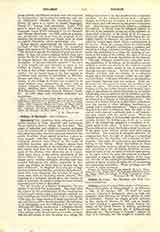

Colman, name of several Irish saints:—(I) COLMAN, Bishop and patron of Kilmacduagh, b. at Kiltartan c. 560; d. October 29, 632. He lived for many years as a hermit in Arranmore, where he built two churches, both forming the present group of ruins at Kilmurvy. Thence he sought greater seclusion in the woods of Burren, in 592, and at length, in 610, founded a monastery, which became the center of the tribal Diocese of Aidhne, practically coextensive with the present See of Kilmacduagh. Although the “Martyrology of Donegal” assigns his feast to February 2, yet the weight of evidence and the tradition of the diocese point to October 29, on which day his festival has been kept from time immemorial, and which was fixed by a rescript of Pope Benedict XIV, in 1747, as a major double.
COLMAN, of Templeshambo, was also a Connacht saint, and has been confounded with the patron of Kilmacduagh, but he lived somewhat earlier, and The sphere of his ministry lay in the present County Wexford. He was a contemporary of Saint Aidan, who appointed him Abbot of Templeshambo, the mother church of Enniscorthy. Many legends are told of Saint Colman and of his holy well with its sacred ducks, but certain it is that he labored zealously at the foot of Mount Leinster, his monastery being known as Temple Sean Bothe. He died c. 595 on October 27, on which day his feast is recorded in the “Martyrology of Donegal”.
COLMAN MAC LENINE, founder and patron of the See of Cloyne, b. in Munster, c. 510; d. November 24, 601. He was endowed with extraordinary poetic powers, being styled by his contemporaries “Royal Bard of Munster“. The Ardrigh of Ireland gave him Cloyne, in the present County Cork, for his cathedral abbey, in 560, and he labored for more than forty years in his extensive diocese. Several of his Irish poems are still extant, notably a metrical panegyric on St. Brendan. Colgan mentions a metrical life of St. Senan by him. His feast is observed on November 24. Another St. Colman is also venerated on the same day, as recorded by St. Aengus in his “Felire”: Mac Lenine the most excellent With Colman of Duth-chuilleann.
COLMAN, founder of the Abbey and Diocese of Mayo, b. in Connacht, c. 605; d. August 8, 676. He became a monk of Iona, and so famous were his virtues and learning, as testified by St. Bede, that on the death of St. Finan, in 661, he was appointed Bishop of Lindisfarne. During his brief episcopacy, the Synod of Whitby was held, in 664, as a result of which (St. Colman being a determined protagonist of the old Irish computation), owing to the decision of King Oswy on the Paschal controversy, he resigned his see. Between the years 665 and 667 St. Colman founded several churches in Scotland, and, at length, accompanied by thirty disciples, sailed for Ireland, settling down at Innisbof£in, County Mayo, in 668. Less than three years later he erected an abbey, exclusively for the English monks in Mayo, subsequently known as “Mayo of the Saxons”. His last days were spent on the island of Innisboffin. His feast is celebrated August 8.
COLMAN, b. in Dalaradia, c. 450; date of death uncertain. His feast is celebrated June 7. He founded the See of Dromore, of which he is patron and over which he presided as bishop. He studied at Noendrum (Mahee Island), under St. Mochae or Coelan, one of the earliest disciples of St. Patrick. Many interesting stories are told of his edifying life at Noendrum and the miracles he worked there. To perfect his knowledge of the Scriptures St. Colmanwent to the great school of Emly, c. 470 or 475, and remained there some years. At length he returned to Mahee Island to see his old master, St. Mochae, and remained under his guidance for a long period, acting as assistant in the school. Among his many pupils at Mahee Island, in the first quarter of the sixth century, was St. Finian of Moville.
COLMAN ELO and COLMAN MACCATHBAD are also famed in Irish hagiology. The former was founder and first Abbot of Muckamore, and from the fact of being styled “Coarb of MacNisse”, is regarded as Bishop of Connor. He was born c. 555 in Glenelly, in the present County Tyrone, and d. at Lynally in 611, September 26, on which day his feast is celebrated. He studied under his maternal uncle, St. Columcille, who procured for him the site of a monastery now known as Lynally (Lann Elo). Hence his designation of Colmanellus or Colman Elo. Subsequently he founded the Abbey of Muckamore, and was appointed Bishop of Connor. He is also known as St. Colman Macusailni. The latter saint, distinguished as Mac-Cathbad, whence Kilmackevat, County Antrim, was Bishop of Kilroot, a minor see afterwards incorporated in the Diocese of Connor. He was a contemporary of St. Ailbe, and his feast has been kept from time immemorial on October 16.
ST. COLMAN, one of the patrons of Austria, was also an Irish saint, who, journeying to Jerusalem, was martyred near Vienna, in 1012, October 13, on which day his feast is observed. His life, written by Erchenfrid of Melk, is in “Acta SS.”, VI, 357 and “Mon. Germ. Hist.: Script.”, IV, 647.
W. H. GRATTAN-FLOOD

